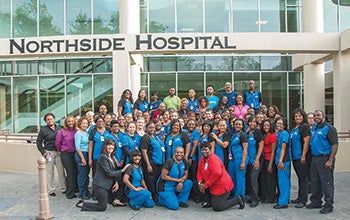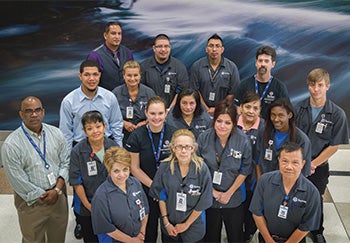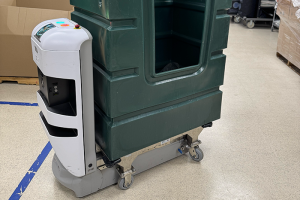2015 Environmental Services Departments of the Year

The Environmental Services Department of the Year in the 450 or more beds category is Northside Hospital in Atlanta.
Great environmental services (ES) teams take time to build. They require a strong leader with a clear vision, laserlike focus, tools and the resources to enable staff to continually advance their skills, and managers with the ability to recognize when outside resources are needed to achieve the defined standard of excellence.
That’s exactly what Northside Hospital’s ES team in Atlanta did to transform its operations to achieve top-level performance. How the team got there is another story.
The team’s transformation began four years ago, when Fiona Nemetz, CHESP, joined the hospital as director of environmental services, safety and security. Since then, the team has learned valuable lessons about the power of data, the value of effective partnerships and how to leverage the two to achieve sustained improvement in patient satisfaction, efficiency and other areas.
You may also like |
| ES Department of the Year 2014 winners |
| ES Department of the Year 2013 winners |
| ES Department of the Year 2012 winners |
|
|
In a close working relationship with its management service partner Aramark, the ES team has made significant improvement in just about all of its key metrics. Nemetz and Dan Beaver, Aramark general manager, note that the journey hasn’t always been easy, but the willingness of managers and front-line staff alike to accept responsibility and be accountable for improving the patient experience has fueled sustained success at the 537-bed facility with 1.2 million sq. ft. of cleanable space.
Beaver says Aramark’s role with the Northside ES team is “to provide partnership in leadership that aligns with the organization’s goals and outcomes.” Nemetz notes that mission has been fulfilled.
“Our managers understand the importance of their responsibility to give our employees the training and the tools to get the job done so that when an employee spends that 12 minutes in front of the patient, it is an awesome experience,” Nemetz says.
A large majority of Northside Hospital’s patients share that view. The hospital’s HCAHPS “top box” survey scores for environmental cleanliness — meaning respondents indicated the room was “always” clean during their stay — have steadily risen from 73.2 percent in 2012 to 78.6 percent in 2014 and, so far in 2015, have surpassed 80 percent.
Mastering fundamentals
What’s driving the team’s success?
The department’s leaders excel at the fundamentals of training and implementing a role-playing program to help staff comfortably engage patients. All staff members are taught the finer points of service recovery and they have the tools — verbal and otherwise — to respond to patients who express dissatisfaction with any aspect of care or service.
By appointing a “bed czar” and implementing a more robust bed management software system, the ES team last year cut room turnaround times by nearly one-third. In addition, ES leaders regularly round with their direct reports and, separately with the nursing staff, to identify performance improvement opportunities.
Taking patient satisfaction efforts up a notch, the ES department last year modified its turndown service for patients upon request — successfully engaging more patients to take advantage of the extra attention offered. The so-called “white glove” service includes an evening refreshing of the room and bathroom (including floor mopping), removing trash and looking for other cleaning opportunities.
Elsewhere, the ES team partnered with the bone marrow transplant unit team when the unit initiated a hand hygiene-monitoring program. The effort includes electronic tracking of the use of hand sanitizer within the department and providing valuable information regarding patient care and clinical hygiene, notes Permecia Winston, quality improvement specialist for environmental services.
These are just a handful of the reasons that judges selected Nemetz’s team as the 2015 Environmental Services Department of the Year. The award, issued by the Association for the Healthcare Environment and media sponsor Health Facilities Management, recognizes outstanding performance in 14 critical areas.
Environmental Services Department of the Year |
Winner450 or More Beds CategoryNorthside Hospital Atlanta Fiona Nemetz, CHESP director of environmental services, safety and security 150 Beds or Fewer CategorySeton Medical Center Williamson Round Rock, Texas Enrique Marquez environmental services director (Touchpoint Support Services) Certificate of Merit450 or More Beds CategoryUniversity of Washington Medical Center Seattle Jose Rodriguez manager of program operations 150 Beds or Fewer CategorySpecialty Hospital Jacksonville, Fla. Tammy E. Fitch director of environmental services Blanchard Valley Hospital Findlay, Ohio Robin Cramer environmental services/linen/communications/hazardous materials manager Huntsman Cancer Institute Salt Lake City Linda C. Rogers environmental services manager JudgesMarci A. Butts, director of ancillary and support services, The Jewish Hospital–Mercy Health Cincinnati J. Hudson Garrett Jr., Ph.D., vice president, clinical affairs, PDI Inc., Orangeburg, N.Y. Walter Vernon, president, Mazzetti, San Francisco |
Data-driven success
The foundation of the team’s successes is a deep commitment to capturing and understanding data that measure such metrics as surface-cleaning thoroughness, hand-hygiene compliance and patient satisfaction with room cleanliness.
Nemetz credits the organization’s partnership with Aramark for helping to provide many of the support tools needed to bring actionable data and daily coaching to the ES team.
“Our progressive journey began with a partnership of building the leadership team. Expectations of leaders were established and leaders were evaluated through the Aramark/Northside partnership to determine the right team was in the right seat on the right bus,” Nemetz explains.
The partners focused on such big-picture issues as scheduling to achieve the quality level set by the leadership team and identifying opportunities to improve patient satisfaction.
Front-line leaders like Kevin Barker, an Aramark Healthcare employee who serves as operations manager in Northside’s med-surg tower, help to impart daily the difference that each ES staff member can make in his or her time with patients.
“I have a philosophy that each person has an opportunity every day to make a difference in somebody’s life. That is my passion. That is why I’m in this business, and I try to pass that on to the people who work here so that we can deliver that superior excellence to all of our patients, their family members and our staff,” Barker says.
Staff clearly have taken to this approach. The results can be seen in the hospital’s steadily rising HCAHPS scores in areas like environmental cleanliness. Nemetz notes that there is now teamwide accountability on the latest patient satisfaction scores.
“Early on, I started going straight to the Press Ganey website at home at 5 a.m. and then coming in to talk about the results. Today, there’s not a manager here who doesn’t know what those scores are by the time I come in each day,” Nemetz says.
Achieving satisfaction
Michael Jackson, assistant director for environmental services at Northside and an Aramark employee, says the organizationwide commitment to delivering patient-centered care requires that the ES team members maintain a continual focus on positive patient interactions.
“In environmental services, we’re not the revenue generators of the hospital, so we have to show administrators the value that we deliver. Yes, the hospital is clean, but the value we bring is the customer service piece. That’s going to keep people coming to the hospital,” Jackson says.
Lucy Petty, Aramark operations manager in the Women’s Center, which had the highest patient satisfaction scores in the hospital last year, helped to teach staff how to successfully engage patients and family members during their regular cleaning rounds.
Petty developed role-playing scenarios to help staff members communicate effectively in difficult situations such as dealing with an upset patient or how to comfortably engage family members in the room. She took input from the staff on common challenges they face to help promote staff buy-in of the program.
Petty credits these exercises, where staff members alternate playing the role of a patient and housekeeper, as being a “great game-changer with our satisfaction scores.”
Perhaps best illustrating the level of customer service that Nemetz and her team are trying to achieve is staff member Marvin Dennis, who last year received the Kimberly-Clark Professional Heart of Healthcare award. The award recognizes ES technicians who make a difference for patients.
“Marvin is a model environmental service staff member and has set the bar for patient satisfaction. His patient satisfaction scores have created a healthy competition among staff members,” Nemetz says. “Given his previous success, employees are now challenged to create new initiatives to wow our patients.”
Demonstrating just how much the organization values the interpersonal skills of ES staff, Nemetz says her department’s hiring process emphasizes personality and customer service skills over the technical aspects of the job.
“We can teach you the technical skills, but if you don’t have those integral interpersonal skills, you’re not going to make it here,” Nemetz says.
Bob Kehoe is a senior editor with Health Facilities Management.

Members of the environmental services team at Seton Medical Center Williamson are trained to make the patient experience the best possible.
It's all about the patient
For the environmental services (ES) department at Seton Medical Center Williamson, Round Rock, Texas, the goal is simple: Always do what you can to ensure an excellent patient experience.
A combination of instituting innovative staffing ideas and maintaining open communication along with an ongoing commitment to excellence through staff development and selective use of new technology have proven to be a highly successful formula for Enrique Marquez, environmental services director, and his team of nearly 35 full-time associates.
That formula enabled the ES department at Seton Williamson, operated by TouchPoint Support Services, Atlanta, to be named the Environmental Services Department of the Year in the small hospital category of 150 beds or fewer in the annual competition conducted by the Association for the Healthcare Environment and media sponsor Health Facilities Management.
The list of accomplishments is strong and steady since Marquez came on board a few years ago for TouchPoint. Turnaround times for preparing patient rooms have decreased about 35 percent. The medical center’s volume of recycling has expanded along with the use of green supplies for cleaning and sanitizing. Since the department took over linen services, the amount being laundered has decreased, generating a tidy savings.
Perhaps most importantly, the department’s HCAHPS scores have trended upward from below 70 to up to 85 on average, Marquez says.
“Our main goal here at Seton Medical Center Williamson is to ensure that the patient is getting excellent service, which means low wait times and high-quality customer service all the time,” Marquez says. The department cleans more than 310,000 sq. ft. of space in the 144-bed hospital.
Saying it is one thing, achieving it takes a plan along with lots of hard work, dedication, transparency and open communication, all with the intent of transforming care. The medical center, which is part of Ascension Health, St. Louis, the largest nonprofit health system in the United States, makes open dialogue from the top down a systemwide directive.
Daily meetings between hospital and department leaders help to solve any problems or challenges as they arise, Marquez says. At the start of each shift, the ES department holds quick meetings to discuss any staff-related issues, such as those concerning safety or patient service.
Monthly meetings and annual staff surveys by TouchPoint provide an opportunity for feedback, he says. He also encourages staff to solicit input from patients and staff in other departments so that any problems are quickly resolved.
“The main part about any successful business is drilling down to the front-line staff and finding out how they feel about it,” Marquez says. “The leadership can make policy, but the arrow doesn’t move without an engaged staff. They are the ones who drive the wheels. We want to empower our associates so they can deliver the best customer and patient care.” TouchPoint’s emphasis on training and ongoing staff development is critical to the department’s success, he says. “We want to ensure that all staff members have the education and tools they need to perform their jobs to the utmost of their ability,” Marquez says.
New staff go through extensive classroom training before they work with a lead associate who grooms new hires with on-the-job training. Training continues less formally with the “daily lineups” that kick off each shift every day to discuss HCAHPS scores, safety, customer service, patient throughput and more, he says.
Infection prevention is a focus. Training includes and continually re-emphasizes a 10-step process that ensures thorough cleaning of all patient rooms on a routine basis. Marquez stepped up use of adenosine triphosphate hygiene monitoring systems to keep closer tabs on the thoroughness of patient room cleaning. The department also installed touchless hand sanitizers to aid in infection prevention.
Another key element of the ES department’s daily regimen is Team Clean, Marquez’s idea to boost HCAHPS scores and improve total cleanliness by utilizing associates’ individual strengths to give patients the best experience possible.
Marquez determined that the housekeepers generally fell into one of two categories. One group excelled at efficient, effective cleaning of patient rooms with minimal interaction and a second group thrived at the social part of the job while still helping to provide a high level of cleanliness.
Because HCAHPS scores were influenced heavily by how patients were treated and not just the cleanliness of the room, Marquez paired up staff members with separate strengths to clean rooms together. One focuses on cleaning areas near the patient so they can socialize with him or her as they work and the second staff member cleans the bathroom area and other spots.
HCAHPS scores began to climb from 68 to 72 to an average of 82 to 86 and have stayed there, he says. “Environmental services is a major part of the patient experience, creating that healing environment for the patient not only physically but emotionally as well,” he explains.
The Team Clean program, which required no change in staffing level, has been so effective over the past year-plus that other facilities in the Seton family of hospitals already have started implementing the process.
Team Clean along with expanded use of the Teletracking software system to aid in facility throughput that the medical center already had in place reduced patient room turnaround times. The system allows managers to monitor the status of patient rooms and discharges in real time and assign or reassign staff as needed.
To stay in line with the nearby City of Austin’s sustainability push, the department negotiated with its waste haulers to institute a single-stream system to simplify the process. The move has resulted in more waste being diverted from landfills, he says.
The department also expanded its green initiative to purchase as many green cleaning products as possible and to use chemical-free floor scrubbing and stripping equipment, Marquez says. Additionally, the hospital recently received GreenGuard indoor air quality certification.
Another green initiative that the department undertook was the stocking and distribution of linen supplies for the facility. By analyzing usage, the department reduced pounds per adjusted patient day (PPAD) from 16-plus pounds per patient to 11.52 PPAD. The reduction translates to annual savings of about $100,000, while also reducing water and energy usage.
Marquez says one of the most gratifying parts of his job is receiving letters from patients who express gratitude for excellent ES work and for the personal touches that bring them joy. These actions could be as simple as praying with the patient, combing his or her hair or bringing flowers, he says.
One letter recognizing the kindness of three staff members especially touches Marquez. “To know that not just one but three of our associates impacted this patient to where he took the time to write what an amazing job they did is great. Most of the time they do a thankless job,” he says. “I am very proud of the team.”
Jeff Ferenc is senior editor at Health Facilities Management.



